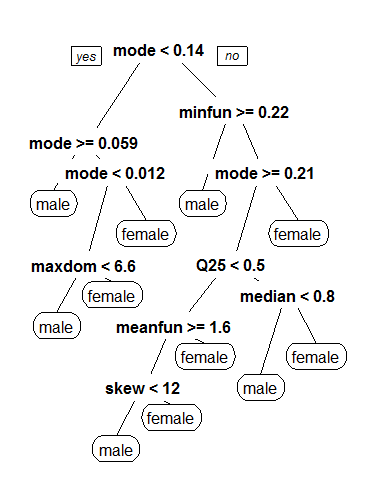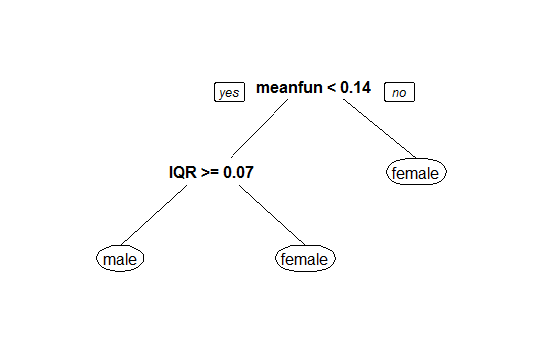Voice Gender
Gender Recognition by Voice and Speech Analysis
Run the online demo.
Read the full article Identifying the Gender of a Voice using Machine Learning.
This project trains a computer program to identify a voice as male or female, based upon acoustic properties of the voice and speech. The model is trained on a dataset consisting of 3,168 recorded voice samples, collected from male and female speakers. The voice samples are pre-processed by acoustic analysis in R and then processed with artificial intelligence/machine learning algorithms to learn gender-specific traits for classifying the voice as male or female.
The best model achieves an accuracy of 100% on the training set and 89% on the test set.
Update: By narrowing the frequency range analyzed to 0hz-280hz (human vocal range), the best accuracy is boosted to 100%/99%.
The Dataset
Download the pre-processed dataset as a CSV file.
The CSV file contains the following fields:
"meanfreq","sd","median","Q25","Q75","IQR","skew","kurt","sp.ent","sfm","mode","centroid","meanfun","minfun","maxfun","meandom","mindom","maxdom","dfrange","modindx","label"
"label" corresponds to the gender classification of the sample. The remaining fields are acoustic properties, detailed below.
In R, you can load the dataset file data.bin directly as a data.frame with the command load('data.bin').
In addition to the pre-processed dataset, the raw voice samples used for training are included as .WAV files in a separate repository. The .WAV files are pre-processed in R to produce the above dataset.
Accuracy
The trained models have achieved the following accuracies (train/test):
Baseline Algorithm (always male)
50%/50%
Baseline Algorithm (simple frequency threshold)
61%/59%
Logistic Regression
72%/71%
Classification and Regression Tree (CART)
81%/78%
Random Forest
100%/87%
Generalized Boosted Tree Regression
91%/84%
XGBoost
100%/87%
XGBoost (Updated with frequency range 0hz-280hz)
100%/99%
Acoustic Properties Measured
The following acoustic properties of each voice are measured:
- duration: length of signal
- meanfreq: mean frequency (in kHz)
- sd: standard deviation of frequency
- median: median frequency (in kHz)
- Q25: first quantile (in kHz)
- Q75: third quantile (in kHz)
- IQR: interquantile range (in kHz)
- skew: skewness (see note in specprop description)
- kurt: kurtosis (see note in specprop description)
- sp.ent: spectral entropy
- sfm: spectral flatness
- mode: mode frequency
- centroid: frequency centroid (see specprop)
- peakf: peak frequency (frequency with highest energy)
- meanfun: average of fundamental frequency measured across acoustic signal
- minfun: minimum fundamental frequency measured across acoustic signal
- maxfun: maximum fundamental frequency measured across acoustic signal
- meandom: average of dominant frequency measured across acoustic signal
- mindom: minimum of dominant frequency measured across acoustic signal
- maxdom: maximum of dominant frequency measured across acoustic signal
- dfrange: range of dominant frequency measured across acoustic signal
- modindx: modulation index. Calculated as the accumulated absolute difference between adjacent measurements of fundamental frequencies divided by the frequency range
Classification and Regression Decision Tree
The following decision tree, produced by the CART model, provides a high-level overview of important properties of the voice samples that may determine a specific gender classification of male versus female.
After narrowing the frequency range to 0hz-280hz with a sound threshold of 15%, the accuracy is boosted to near perfect, and the following CART model is described. Mean fundamental frequency serves as a powerful indicator of voice gender, with a threshold of 140hz separating male from female classifications.
References
The Harvard-Haskins Database of Regularly-Timed Speech
Telecommunications & Signal Processing Laboratory (TSP) Speech Database at McGill University, Home
Festvox CMU_ARCTIC Speech Database at Carnegie Mellon University
Copyright
Copyright (c) 2022 Kory Becker http://primaryobjects.com/kory-becker
Author
Kory Becker http://www.primaryobjects.com

